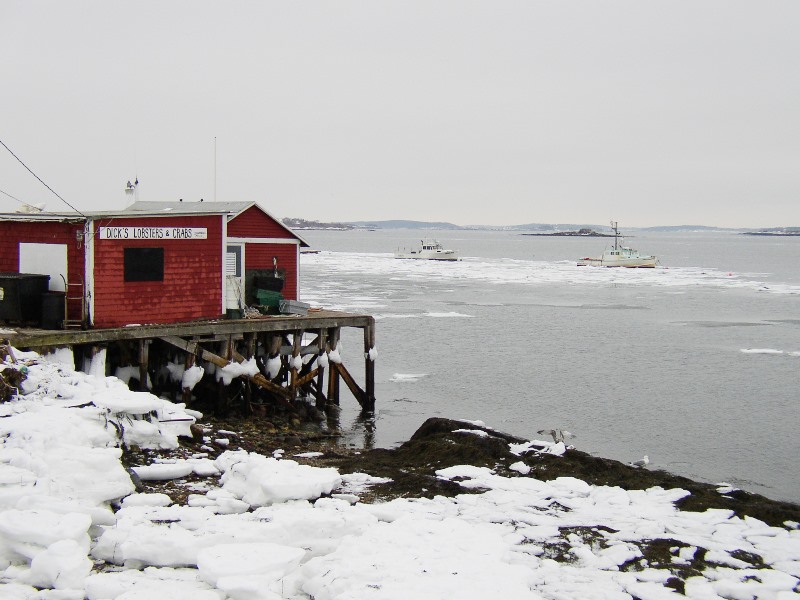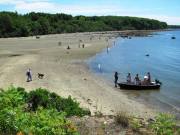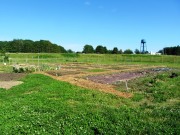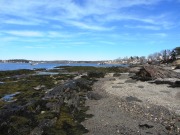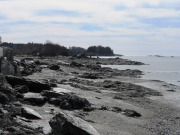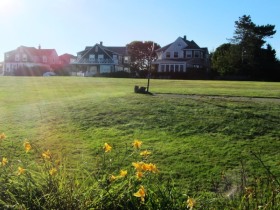Among Harpswell’s villages at the southern portion of Harpswell Neck is West Harpswell, about two miles south of Harpswell Center. South Harpswell begins about a mile farther, where Route 123 branches to Ash Point Road, Basin Point Road, as well as continuing to Potts Point.
West Harpswell is home to Mitchell Field, a 119-acre Town-owned property. It has 2,630 feet of shoreline and 350’ of road frontage along Rt. 123. The Town acquired the property in 2001 from the Federal Government after the Brunswick Naval Air Station Fuel Depot closed in 1992 and the property was remediated of toxic remains from fuel activity. A small additional area was transferred to the town in 2004.
A large portion of Mitchell Field, near the Community Garden, is left undisturbed to allow the nesting of birds such as the Bobolink. A substantial pier, in need of repair, remains from use by U.S. Navy fuel tankers.
South Harpswell is at the tip of Harpswell Neck on the shore of Casco Bay. Potts Point juts into Casco Bay with its small nature preserve at the tip. Potts Harbor has a wharf for lobster landings. A tidal mill once operated nearby.
At Potts Point Preserve one finds tide pools to explore, a gravel beach and dramatic views of Casco Bay. Standing at the southern tip of the preserve, enjoy a view of a number of the islands that make Casco Bay so special including: Haskell, Pinkham, Bailey, Upper Flag, Thrumcap, and Eagle Islands. The preserve is owned by Harpswell Heritage Land Trust.
Stover’s Cove and Stover’s Point are nearby, bearing the family name of early settlers. Stover’s Point hosts a nature preserve and small beach.
In the 1920s, Harpswell’s 1796 “Stover House” was moved by barge, along with the Spite House in Phippsburg, to Rockport. The two were joined to produce a grand house overlooking West Penobscot Bay.
National Register of Historic Places – Listings
Auburn-Harpswell Association Historic District
[Maine Route 123 South Harpswell, known locally as the “Auburn Colony”. (additional photos at Harpswell)]
In a sweeping S formation reaching toward the tidal cove stand ten of the original fourteen cottages of the Auburn-Harpswell Association at South Harpswell. Built between 1901 and 1902, all are in the then popular Shingle Style. Behind the cottages are two large structures: a community dining hall in the Colonialrevival style and an assembly hall in the Greek Revival style. This is the second series of cottages, the first having burned in 1899.
The Colony is one of the best examples on the coast of a planned community, created for the families and friends of the founding Auburn businessmen as a resort for relaxed summer vacationing by the sea. For over a century the Colony has provided all the amenities of relaxed and comfortable vacationing. Residents have meals in the community Dining Hall, bathing in the saltwater pool, and use of the clay tennis court.*
Greene Cottage
Green Cottage
The Greene Cottage was built in 1913 at the southern tip of Basin Point. The bungalow was built as a summer cottage for a middle-class Boston family, who purchased the lot and hired a local contractor. The expansion of summer tourism along the Maine coast started after the Civil War and continued through the 1920s due to a generally strong economy, expanding leisure time and improved transportation networks. As these trends continued to strengthen, more middle-class families were able to build their own summer cottages along the Maine coast. It is a good example of an early 20th century, middle-class summer cottage. The siting of the property to capitalize on views, expansive porch, many bedrooms, open plan, style and form all illustrate the summer cottage type as interpreted by local builders and influenced by a modest budget. With few changes, the building retains most of its original design in 2021.
Stover, Captain Johnson, Jr. House
The circa 1807 Captain Johnson H. Stover Jr. House is significant as a fine example of Federalstyle architecture with mid-nineteenth century Greek Revival style interior updates to several rooms. Its character-defining features include Federal style mantles and trim in the principal rooms and a triple-run stair typical of local early-nineteenth century design. The house was built for a prominent local family and remained in their possession through two generations before becoming a seasonal summer home. This pattern of use and ownership was quite common for architecturally significant Maine coastal houses. It is among the largest and oldest houses in Harpswell and the only house of its size and style on the southern end of Harpswell Neck, where the majority of historic houses show distinctly different Federal style details. The house retains its original location and design since 1807.
Little Mark Island Monument
Little Mark Island Daybeacon
The Little Mark Island Monument was built in 1827 and retains its structural integrity. It is an early 19th century monumental tower daybeacon and lifesaving facility. It is one of two such structures in Maine and is historically significant.
It recalls the long-term Federal government program to improve navigational safety in the United States through building and maintaining aids to navigation and lifesaving facilities. It exemplifies regional stone masonry construction dating to that time. It is still widely recognized as a landmark of Casco Bay’s historic maritime landscape.



